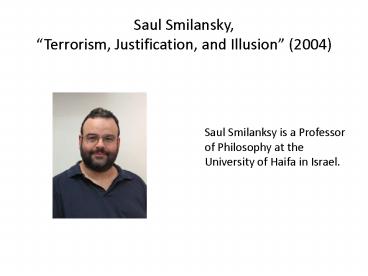Saul Smilansky, Terrorism, Justification, and Illusion 2004 - PowerPoint PPT Presentation
1 / 7
Title:
Saul Smilansky, Terrorism, Justification, and Illusion 2004
Description:
When it is 'aimed at galvanizing public attention to the plight of poor people ... When it is 'aimed at toppling dictatorial regimes and establishing democracy' (p. ... – PowerPoint PPT presentation
Number of Views:110
Avg rating:3.0/5.0
Title: Saul Smilansky, Terrorism, Justification, and Illusion 2004
1
Saul Smilansky, Terrorism, Justification, and
Illusion (2004)
- Saul Smilanksy is a Professor of Philosophy at
the University of Haifa in Israel.
2
A Definition of Terrorism
- There is a broad sense in which terrorism can
be under- stood as intentionally targeting
noncombatants with lethal or severe violence for
political purposes. In ethical terms, this
formulation seems to capture the salient feature
of the practice, the intentional targeting of
noncombatants (and not in the context of crime or
the like). However, I wish to focus here on
terrorism in a narrower sense, as practiced by
members of small or weak groups that lack the
capacity to ?eld an army and engage in warfare.
Henceforth when I speak of terrorism I shall
refer to this narrower sense (p. 569)
3
Two Moral Principles
- a) The Principle of Noncombatant Immunity
(PNI) it is never permissible to aim to kill (or
severely harm) noncombatants PNI forbids
terrorist as well as counter-terrorist activities
aimed at killing (or severely harming)
noncombatants. - b) The Antioppression Exception to PNI PNI is
correct in general, but there are exceptions when
weak forces are ?ghting unjust oppression. In our
context, the Antioppression Exception permits
terrorist targeting of noncombatants if it is
necessary in combating oppressive regimes.
Violating PNI in counter-terrorist activity is
still, however, forbidden (pp. 569-570).
4
Smilanskys Thesis
- By and large where there has been terrorism
it has not been justi?ed, and where it perhaps
could have been justi?ed, it has not occurred
(p. 575)
5
Three Case of Unjustifiable Terrorism
- IRA
- Palestinians
- Al-Qaida
6
Three Cases of Possibly Justifiable Terrorism
- When there is a clear danger to a groups very
existence or the mass extermination of
noncombatants. - When it is aimed at galvanizing public attention
to the plight of poor people in the Third World. - When it is aimed at toppling dictatorial regimes
and establishing democracy (p. 574)
7
Five Moral Illusions
- The illusion of the ef?cacy of justi?cation
that processes of credible ethical re?ection and
justi?cation can be relied upon in generating
what actually happens. - The illusion that the major instances of modern
terrorism have a signi?cant justi?cation. - The overwhelming spread and force, in our
context, of illusionsnationalistic, religious,
ethnic, and culturalirrational forces carrying
great emotional weight with millions of people
and leading to terrorism and the support of
terrorism. - The arguably positive illusory belief,
encouraged by the international laws of warfare,
that terrorism is never justi?ed, as embedded in
something such as the absolutist constraints of
PNI. - The illusion that we might and should permit
this line to be crossed, but only in the ?ght by
the weak against oppression (the Antioppression
Exception) (p. 579).































![get⚡[PDF]❤ Grand Illusion: The Myth of Voter Choice in a Two-Party Tyranny PowerPoint PPT Presentation](https://s3.amazonaws.com/images.powershow.com/10049478.th0.jpg?_=202406070112)